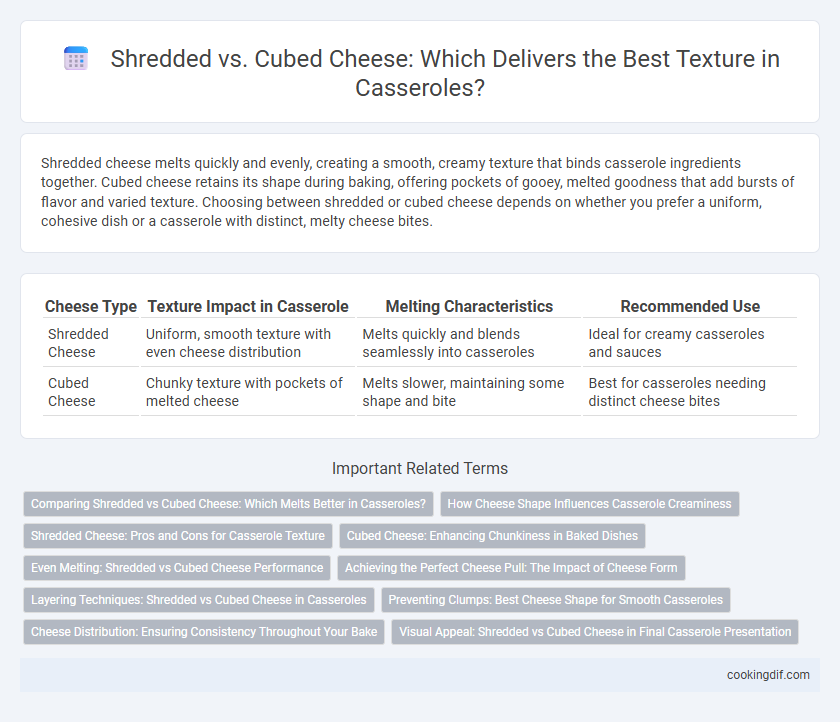Shredded cheese melts quickly and evenly, creating a smooth, creamy texture that binds casserole ingredients together. Cubed cheese retains its shape during baking, offering pockets of gooey, melted goodness that add bursts of flavor and varied texture. Choosing between shredded or cubed cheese depends on whether you prefer a uniform, cohesive dish or a casserole with distinct, melty cheese bites.
Table of Comparison
| Cheese Type | Texture Impact in Casserole | Melting Characteristics | Recommended Use |
|---|---|---|---|
| Shredded Cheese | Uniform, smooth texture with even cheese distribution | Melts quickly and blends seamlessly into casseroles | Ideal for creamy casseroles and sauces |
| Cubed Cheese | Chunky texture with pockets of melted cheese | Melts slower, maintaining some shape and bite | Best for casseroles needing distinct cheese bites |
Comparing Shredded vs Cubed Cheese: Which Melts Better in Casseroles?
Shredded cheese melts faster and more evenly in casseroles due to its increased surface area, creating a creamy, cohesive texture. Cubed cheese retains more of its shape, providing pockets of gooey cheese but less overall uniform melting. For smooth, consistent casseroles like macaroni or vegetable bakes, shredded cheese is the preferred choice, while cubed cheese suits dishes where distinct cheese bites are desired.
How Cheese Shape Influences Casserole Creaminess
Shredded cheese melts more quickly and evenly in casseroles, creating a smooth, creamy texture throughout the dish. Cubed cheese melts slower, resulting in pockets of gooey, melted cheese that add varied texture and richer bursts of flavor. Choosing shredded cheese enhances overall creaminess, while cubed cheese offers a chunkier, more textured melt experience in casseroles.
Shredded Cheese: Pros and Cons for Casserole Texture
Shredded cheese melts quickly and evenly, creating a smooth, creamy texture that enhances casseroles by blending seamlessly with other ingredients. It distributes more uniformly, preventing clumps and allowing for a consistent cheesy flavor throughout the dish. However, shredded cheese can sometimes release excess moisture, potentially making the casserole slightly watery or less firm in texture.
Cubed Cheese: Enhancing Chunkiness in Baked Dishes
Cubed cheese enhances casserole texture by providing distinct, melty pockets that maintain their shape, offering a satisfying chunkiness in every bite. Unlike shredded cheese, which melts uniformly and creates a smoother consistency, cubed cheese adds visual appeal and varied mouthfeel to baked dishes. This method is ideal for casseroles where textural contrast is desired, such as in vegetable or meat-based recipes.
Even Melting: Shredded vs Cubed Cheese Performance
Shredded cheese melts more evenly in casseroles due to its increased surface area, allowing heat to distribute uniformly and creating a smoother, creamier texture. Cubed cheese tends to melt unevenly, often resulting in pockets of melted cheese surrounded by firmer, less melted chunks. For casseroles requiring consistent texture and melt, shredded cheese offers superior performance compared to cubed cheese.
Achieving the Perfect Cheese Pull: The Impact of Cheese Form
Shredded cheese melts evenly in casseroles, creating a smooth, stretchy cheese pull that enhances texture and visual appeal. Cubed cheese offers pockets of melty goodness with a firmer bite, adding a varied mouthfeel but less uniform stretchiness. Choosing shredded cheese optimizes the classic gooey pull, while cubes provide distinct cheesy bursts throughout the dish.
Layering Techniques: Shredded vs Cubed Cheese in Casseroles
Shredded cheese melts more evenly and creates a smoother, cohesive texture throughout the casserole, enhancing the overall creaminess and binding ingredients effectively. Cubed cheese provides distinct pockets of melted cheese that add bursts of flavor and a varied texture experience with each bite. Choosing between shredded and cubed cheese for layering techniques depends on whether a uniform melt or textured cheese distribution is desired for optimal casserole presentation and taste.
Preventing Clumps: Best Cheese Shape for Smooth Casseroles
Shredded cheese melts evenly, preventing clumps and ensuring a smooth casserole texture, while cubed cheese tends to retain its shape and can create uneven pockets of melted cheese. For casseroles requiring a creamy, cohesive consistency, finely shredded cheese distributes heat more uniformly, reducing the risk of greasy or clumpy spots. Choosing shredded cheese enhances the overall mouthfeel and appearance of baked dishes by promoting consistent melting throughout the casserole.
Cheese Distribution: Ensuring Consistency Throughout Your Bake
Shredded cheese melts more evenly throughout a casserole, creating a consistent, creamy texture that binds ingredients smoothly. Cubed cheese offers distinct pockets of flavor and firmer bites, but may result in uneven cheese distribution and texture. For uniform melting and cohesive consistency, shredded cheese is preferred in casseroles.
Visual Appeal: Shredded vs Cubed Cheese in Final Casserole Presentation
Shredded cheese melts uniformly, creating a smooth, golden-brown crust that enhances the casserole's visual appeal with even coverage and subtle browning. Cubed cheese offers a more rustic presentation, with distinct pockets of melted cheese that provide varied texture and visible cheese chunks throughout the dish. Choosing shredded cheese emphasizes a sleek, cohesive look, while cubed cheese adds depth and eye-catching contrast in the casserole's final presentation.
Shredded vs Cubed cheese for casserole texture Infographic

 cookingdif.com
cookingdif.com